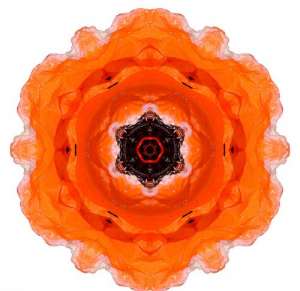第二个障碍 The Second Obstacle
Part 2: Walking The Path 第2篇:行道
2-2. The Path of Peace 平静之道
2-2-1. Practicing Dhamma 修习佛法
2-2-1-3. The Second Obstacle 第二个障碍
The second obstacle in developing insight is that when we begin to understand and see this point, we are able to destroy greed, hatred and delusion to some extent; but at the same time, joy is lying concealed within it. The Buddha says this is still not right. Joy is darkness, but it is white darkness. Joy is due to our satisfaction and pride that we can do it. White darkness is frightening because it is hard to see. Black darkness is easy to see because it is dark. Being caught up in joy is to see wrong as right; because as soon as we can destroy some defilements, we don't watch at the point where the defilements are destroyed, but we get sucked into the point where joy arises. Therefore joy is an obstacle in attaining higher stages to Nibbana.
修习内观的第二个障碍就是,当我们了解及看见这点(即佛法的要点是修心与看见念头),我们的修行便能够断除贪、瞋、痴到某一程度,但是要注意!喜悦也就同时暗藏在里头了。佛陀说这还是不对,喜悦是黑暗,而且是白色的黑暗,这种喜悦是由于自满和自傲我们能修到这个程度所引起的。黑色的黑暗因为是黑色,所以容易看见,白色的黑暗很难看见,所以是更可怕的。被缠在喜悦之中是由于把错的看成对的,因为当我们能断除一些烦恼时,我们在烦恼被断除的那个当下没有看见(心念),而在喜悦生起的那个当下卷入其中。因此喜悦是在趣向更高层次涅槃圣果时的一种障碍。
Being caught up in joy is equal to being caught up in thinking. A thought comes up and we get caught up in the thought; so we don't see the thought. When we get caught up in joy, we don't see joy; and we're just content with joy. Because of this, the Buddha teaches us to pull ourselves out of the thoughts that we're thinking, to stand outside of it. Then we will see our thoughts.
被缠在喜悦中就等于被缠在念头之中。当念头生起时,我们被缠在其中,所以才没看见念头;当我们被缠在喜悦之中,我们就不能看见喜悦,而满足于喜悦之中﹝不见庐山真面目,只缘身在此山中﹞。因为这样,佛陀教导我们:要把我们自己从想东想西的念头中拉出来,站到它的外面来,这样才能看见我们的念头。
People who still don't know and see their thoughts say just the same, that they know thought. But in reality they don't understand that thoughts come up continuously, and they get caught up in them. Those who have joy or are attached to the peace of tranquility-meditation are the same. They are caught up in peacefulness, don't know that peace is delusion, and thus get caught up in peace. It is comparable to someone who doesn't know how to turn on the light. He or she turns the light bulb. No light appears. The person who pulls him or herself out of thought and knows and sees thoughts may be compared to someone who know how to turn on the light; that person turns on the switch and light does appear. So we have to know the origin of thought and come to an understanding with these little thoughts of ours. Then we will have as much ability as an electric light in brightening the interior of the mind, just as one correctly turns on the light with the switch. When we're looking at our minds, there is no greed, hatred and delusion. But the moment that we're not looking and lose awareness, greed, hatred and delusion can come back, and we can get caught up in them. It's just like a car driving along the road. At the place where the car passes there is a wind blowing behind it; leaves and dust flap and flutter at the back of the car. Thoughts of greed, hatred and delusion flash up for a moment, and we follow them. How can we still say that we know thought? In reality we don't see thought, but we get caught up in it.
很多还不能知道和看见自己念头的人,往往都会说他们知道和看见念头,但实际上他们并不懂什么是知道和看见,为什么呢?因为他们的念头还在不停地生起,且他们被缠于其中。那些得到喜悦或迷执于止禅的平静的人也是一样,他们被缠在平静之中,他们不知道那种平静是一种迷惑,因而缠于平静之中。这就像一个不知道如何开灯的人,他不按开关而拼命去转灯泡,因此灯不会亮;而一个把自己从念头中拉出来并且知道并看见念头的人,就像一个知道如何开灯的人,他按下开关,灯就亮了。所以,我们必须知道念头的起处,并且了解这些细微的念头,这样,我们就会像按下开关正确开灯的那个人一样,拥有如电灯一般的光明,照亮我们内心。当我们看见自己的心时,就没有贪、瞋、痴;反之,当我们没有看见且没有觉知念头的当下,贪、瞋、痴就又会回来,并且我们会被缠在其中,这就像在路上跑的一辆车,一路上车后都有风在吹着,而树叶和灰尘在车后飘动飞扬,贪、瞋、痴的念头剎那而起,且我们跟着它们团团转,这样我们怎么还能够说我们知道念头呢?实际上我们没看见念头,而是缠于其中。
The Buddha teaches that whoever doesn't see one's own thoughts is a heedless person. Heedlessness is poison to one's life, it's like being dead. This is what I said: It stinks! The Buddha said that there is nothing that stinks as much as the mind that has greed, hatred and delusion, the mind that is stained, the dirty mind.
佛陀教导我们:没有看见自己念头的人,是个没有正念的人。没有正念是一个人生命的毒药,就等于死了一样!我得这么说:它奇臭无比!佛陀也说过:没有任何东西比有贪瞋痴的心还臭!这种心是染污的,是肮脏的心。
Our real mind isn't dirty of stained at all. It's like a light bulb. The filament in the bulb is not dirty, but dust can settle on the outside of the bulb; the inside is still as bright as before. Or we could compare it with the sun. When clouds obscure the light from coming to the earth, it gets dark; but the sun is still as bright as before.
我们真正的心是一点都没有染污肮脏的,它就像是个灯泡,灯泡内的灯丝没有脏,所以,虽然灰尘落在灯泡外面,外面的灯光会暗一点,但里面还是像以前一样明亮。或者我们可以用太阳来比喻:当乌云遮住了太阳,阳光照不到地球,天色就会变暗,但是,这时太阳还是像以前一样明亮。
(Vijja-Avijja 明-无明)
People who don't see thought and get caught up in thought are called people in the cycle of dependent origination; they are people that don't know.

没看见念头而缠于念头中的人叫做落在缘起的循环之中的人,他们是不知道(无明)的人。
We've probably heard this: Avijja is the condition for formation to arise; formations are the condition for the birth of consciousness; consciousness conditions mentality/materiality; mentality/materiality conditions the six senses; the sis senses condition contact; contact conditions feeling; feeling conditions craving; craving conditions clinging; clinging conditions being; being; conditions birth; and birth conditions old age, death and suffering. It's a cycle. Avijja translates as not knowing; we say that we know, but we don't see our minds. Instead we get caught up in thought. As for the word Vijja, it means knowing, seeing one's own thoughts. A thought comes up, we see it, and it stops. It's like a cat and a mouse. If we don't have a cat at home, the mice are not afraid; but when we have a cat, it will catch the mice as soon as they show their faces. The mice die of shock when they get caught. They can die even though the cat doesn't bite. They have such shock; never been caught by a cat before. This is similar to our fixing on thoughts in our minds: when a thought comes, we know it in time; and it immediately stops, comes to a halt, can't concoct any further. This is called Vijja, knowing, to know in time, knowing how to prevent, knowing how to solve and knowing how to conquer – just like a cat and a mouse.
我们可能听过:无明是行生起的条件,行是识生起的条件,识缘起名色,名色缘起六入,六入缘起触,触缘起受,受缘起贪爱,贪爱缘起执取,执取缘起存在(有),存在(有)缘起生,而生缘起老、死和苦;这是循环不断的。“Avijja(无明)”翻译为不知道;意即我们没看见自己的心,反而缠于念头之中。至于“Vijja(明)”,意思为知道并看见自己的念头,也就是,一个念头生起,我们就看见它,使它止灭。这就像是猫捉老鼠:如果家里没有猫,那老鼠就不会害怕,但如果我们有猫,只要老鼠一露面,猫就会去抓牠。老鼠被抓到时会惊吓而死,即便猫还没咬下去,它们可能就吓死了,因为牠们以前从未被猫抓过,所以吓成这样。这和我们觉知心中的念头一样,当一个念头生起,我们当下知道它,它就立刻停下来,并且中断而不能再继续妄想,这就叫做明(Vijja)、知道。这是当下知道,并且知道如何阻止、知道如何解决以及知道如何克服——就像猫捉老鼠一样。
If we don't reflect on the teachings of the Buddha, we don't understand them, and we argue and debate about the teachings, competing with each other. This is not right! Someone who has studied the teaching and employs that knowledge as a tool for killing defilement or dealing with suffering is doing it right, according to the Buddha's intention. These days, we study the Buddhist scriptures until we have degrees, up to the ninth level. Some may look at their own thoughts, but some never watch their minds at all. Whoever has studied but never seen his or her own thoughts, says the Buddha, are like a termite that makes holes and eats books. With academic studies it's the same: studying until one has university degrees, but still never watching one's mind. Such persons know about other people but don't know and see themselves. These people are not considered wise in Buddhism because their knowledge is only of use in an academic way, but is not useful spiritually. When we have a university degree we should deal with our minds also, that is, eliminate defilements, the coarse ones as well as the medium and subtle ones.
如果我们不深思,就不能了解佛陀的教导,并且在这些教导上会起争辩,彼此互不相让,这样是不对的!学过那些教导并且将那些知识当作灭除烦恼或解脱痛苦之工具的人,是依照佛陀的意旨而如法修行。这个时代,我们学习佛教经典只为了获得学位,一直到第九级学位;有些人可能会看他们自己的念头,但有些人就一点都不去看他们的心。佛陀说:「学了教导但却从不去看自己念头的人,就像是一只白蚁只会挖洞和咬书本。」做学术研究的人也一样,他们一直研究到获得大学学位,但从未去看自己的心,这样的人他们只知道外在别人的事,但却从来不向内知道与看见自己。在佛教里,这样的人不被认为是有智慧的,因为他们的知识只能用在学术理论上,而对精神上没有裨益。当我们有了大学学位之后,还是要修治我们的心,也就是说,要灭除烦恼,包括粗、中、细等三种烦恼。
(Going Against The Stream Of Thought 对抗念头的洪流)
We've all probably heard that the Buddha at one time practiced by tormenting Himself, but saw that that method was wrong and stopped it. After that, He partook of food offered by a lady named Sujata. The Buddha asked her, ‘Do you offer just the food or is the tray included as well?’ Se answered that all was offered. Having finished the meal, the Buddha took the tray to the bank of the river and made the following resolution: If He would be Enlightened, may the tray placed on the water flow against the current.
我们可能听过:佛陀曾经藉折磨自己来修行,后来祂明白这方法是错的,于是停止那种修习。随后,他吃了苏佳达(Sujata)女士所供养的食物,且佛陀问她:你是只供养食物还是连盘子也一起供养?她回答说:全部都供养。于是佛陀吃完之后,就带着盘子到河边,把它放在水上,并发愿:假若他能证悟,愿那个盘子能逆流而上。
This is not a true story; it's an illustration and has meaning on the level of the mind. The tray is the mind, the water represents the defilements, and the Buddha working with the mind, is the action of going against the stream. The Buddha didn't let His mind follow the defilements. The current of the water is the current of thought. Following defilements is easy, everyone is doing it already; and so we have suffering!
这不是真实的故事,只是个例子,而且有心灵层面的意涵,盘子是比喻心,水比喻烦恼,而盘子逆流而上则是比喻佛陀对治其心,没有让他的心跟着烦恼走。水流是比喻念流。随烦恼念流而转很容易,每个人都是这样,然而我们也正因此而受苦!
The Buddha practice going against the stream of defilements for the extinguishing of suffering by watching the mind, seeing His own mind thinking. As soon as a thought would come up and there was desire to follow what the eye saw, the ear heard, the nose smelled, the tongue tasted or the body felt, the Buddha saw those thoughts as defilements. He practiced going against the current of thought, not following the thoughts, which want things. Practicing like this, knowledge arose in Him and He was Enlightened.
佛陀为了灭苦,因此藉由观心——看见自己的念头——来对抗烦恼流,当念头一生起,并且有贪欲随着眼见、耳闻、鼻嗅、舌尝或身觉而流转,祂便看见这些念头,并了解它们是烦恼。佛陀精进修习以对抗念头之流,不跟随着那些想东想西的念头流转,祂这样修习,所以自心生起了智慧而觉悟。
The thing that the Buddha points out to us to practice is to know thought with awareness, looking at our own minds. Whatever thought comes up, we should know and understand it, so that the thought does not proliferate further. When thought flashes up, we watch it with awareness; and the thought stops by itself. In practicing Dhamma, the thing to be careful about is the knowledge that knows things outside of ourselves. This kind of knowledge is defilement due to Vipassana. When we have such knowledge, it gives rise to gladness and joy. Joy is called white darkness. It is wrong knowing. Don't get attached to joy! Continuing the practice to the end, until we clearly see our thoughts, their origin and their source, we come at last to the state of arising/passing. It is a break-off, a final exhaustion. I've compared it many times with a rope, tightly tied on both sides and being cut in the middle with a knife. The rope breaks; one cannot pull it together again, that is, one can't use it anymore. The twelve senses are similar: on seeing a form with the eye, on hearing a sound with the ear, etc., let there only just be seeing and hearing and so on. Don't concoct it into beautiful or ugly, good or bad, pleasing or displeasing sound, the sound of a woman, the sound of a man, etc. Just simply see or hear neutrally. But these are still mere words. In practice, we have to look and see and break them apart. When they are broken, there is not more concocting; the senses are not able to reach each other anymore.
佛陀为我们指出的修行之道就是:看我们自己的心,并且用觉性来觉知念头。不管生起什么念头,我们都必须知道并了解它,不要让念头继续扩散,在念头瞬间闪现时,用觉性看住它,念头自然就会停止。修习佛法时,我们必须小心的一样东西便是:对于自己身心以外事物的知解智慧,虽然就某种层面而言,它可以说是一种智慧,但这种智慧仍然是一种修习毘婆舍那而生起的烦恼。当我们有了这样的智慧,会让我们心中感到高兴和喜悦,这种喜悦被称为白色的黑暗,是不正确的智慧,不要执取那种喜悦!要进一步练习直到终点,也就是,直到我们清楚看见念头以及它们的起处而最终达到看见自心生/灭的状态(the state of arising/passing),那就烦恼顿脱并且是永尽无余,我常常用一条两端绑在柱子上且绷得紧紧的绳子来作比喻,当我们用刀在绳子中间切断它:绳子会顿然断开,并且无法再把它拉靠在一起,也就是说,它再也不能作用了。十二处(六根与六尘)也如同这样:当眼睛看见东西、耳朵听到声音…等等的时候,见就只是见、听就只是听…等等(意即根与尘如绳子般断开),不会去分别它是美或丑、好或坏、悦耳或不悦耳、女声或男声…等等,只是单纯中性地看或听,但是这些只是文字说说而已,在修习过程中,我们必须努力去观照、看见并且断开它们,只有当它们断开之后,它们才不会再作怪,十二处(六根与六尘)才不会再彼此接触。
(Cleanliness, Brightness And Peace 清净、光明与平静)
Our Minds are already Clean, Bright and Peaceful! Clean means not dirty, because there are no defilements. Bright means there is wisdom, seeing our minds, or life. Peaceful means having stopped, there is no longer anything further to add.
Our Minds are already Clean, Bright and Peaceful! Clean means not dirty, because there are no defilements. Bright means there is wisdom, seeing our minds, or life. Peaceful means having stopped, there is no longer anything further to add.
到这里我们的心就已经清净、光明与平静了!「清净」意思是不污染,因为没有了烦恼;「光明」意思是具足了智慧,能看见我们的心或生命;「平静」意思是它已止静,不需再另外修什么了。(另译:我们的心本来就是清净、光明与平静的!「清净」意思是它本不污染,因为它元无烦恼;「光明」意思是它本具智慧,本来能见我们的心或生命;「平静」意思是它本已止静,不需再另外修什么而使之平静。
- 准提咒正确念法
- 太上清心咒全文
- 为什么晚上不能听大悲咒
- 超度经文往生咒全文
- 准提咒功德及妙用求财
- 62条人生妙言妙语,帮助你
- 诵大威德金刚咒的感应
- 长寿佛心咒注音
- 普贤行愿品全文诵读含仪轨
- 六字真言作用和功效
- 药师佛心咒正确念诵的方法
- 简单的清心咒口诀
- 六字真言的作用和功能
- 普门品念诵的正确方法
- 准提咒手印全图
- 普贤行愿品回向文全文
- 净身 口 意三业真言拼音
- 金刚经四句偈语解释
- 普贤行愿品全文念诵仪轨
- 道家静心咒原文
- 大悲咒原版30分钟mp3
- 准提咒回向文大全
- 心经可以随便抄吗
- 准提咒全文正确注音
- 天眼看持准提咒人
- 准提咒全文拼音版
- 诵金刚手菩萨圣号的感应故
- 《金刚般若波罗蜜经》
- 楞严咒快速记忆法
- 念坚牢地神咒的感应
- 财神咒念诵108遍
- 药师咒念诵正确方法有哪些
- 准提咒晚上不能念
- 家里播放普庵咒的禁忌
- 普贤行愿品偈颂全文
- 在家诵地藏经正确仪轨及回
- 念大悲咒使人阳气上升
- 《金刚经》全文-金刚经原文
- 女子在家念地藏经注意事项
- 地藏菩萨心咒108遍
- 神龛 The Spirit Shrine
- 礼敬佛陀 Paying Homage To The B
- 破愚痴见惑的阶位:初禅 T
- 直取快捷方式的摘要 Summary
- 矫正观念 Adjusting Views
- 毘婆舍那与平静 Vipassana and
- 直取快捷方式 Taking a Shortcu
- 正确培养觉性,三年便能证
- 正确培养觉知的果报 The Res
- 果报:心地清净 The Result :
- 果报:出世间 The Result Is To
- 果报:当下的天堂与涅槃 T
- 教外之法门 Things Outside of B
- 断烦恼执着的阶位:二禅 T
- 无上的庇护 The Exalted Refuge
- 教外之教导 Teachings Outside o
- 教内之教导 The Teachings insid
- 教内之法门 Things Inside of Bu
- 开光仪式 Opening-Ceremony
- 总结平静之道 Summary
- 庄严圣洁之物 Sacred And Holy
- 平静之道 The Path of Peace
- 幸运日 Lucky Days
- 培养觉知·生起智慧 Developi
- 寂静与涅槃 Peace And Nibbana
- 圣眼与圣耳 Divine Eye - Divine
- 地狱、天堂、涅槃 Hell , Hea
- 善人与恶人 Virtuous People - E
- 善果现起 The Outflow Of Good Re
- 凡与圣 Ordinary Beings and Noble
- 前言 Foreword
- 其它 Miscellaneous
- 具德者的宝藏 The Treasure Of
- 人的种类 Some Types Of People
- 以自为依·如法而行(自依·
- 修学阶段 Stages of Practice
- 了悟平常心:三禅 Normality
- 一掌之叶:觉知 A Handful of
- 了悟人人本具 Knowing that it
- 往生极乐世界 愿心为先
- 悟显法师:华严、法华均圆
- 我修学了凡四训的一些做法
- 张智霖:经营自己的肉身(图
- 惟觉法师:佛法与世间法
- 心律法师:忍辱苦修成大业
- 恬静安逸 清新隽美—评画家
- 我的修学报告:阿难问事佛
- 放生蛇会报恩吗?
- 恭敬心很重要
- 悟妙法师:我经常感到痛苦
- 怎样获得美好姻缘?
- 很想用所学到的佛法知识影
- 悟毅:学佛对我人生的影响
- 想清凉“爽一夏”吗?峨眉
- 往生极乐世界是为了更好地
- 念观音圣号提前合掌往生
- 大安法师:回向的功德是否
- 怎样戒烟
- 心律法师:最好的悟禅之道
- 悟显法师:印经布施开智慧
- 张继宝不孝遭雷殛
- 惟觉法师:六祖坛经 憨山大
- 放生蛇之详细攻略
- 我受了12年的等流果和增上
- 悟强:你快乐吗?谈大方和
- 恭迎伽蓝菩萨圣诞!教您唱
- 我的前半生从死阴的幽谷到
- 大安法师:因微果丰、做怪
- 往生极乐世界最殊胜
- 念佛感应见闻记:阿伽陀药
- 心律法师:脱掉你脆弱的外
- 悟显法师:口业清净不染尘
- 念佛不出声心里默念可以吗
- 悟演法师:三止三观
- 感恩上净下空老法师
- 很重要,去寺院吃饭要注意
- 悟显法师:万般将不去,唯
- 想看到僧宝的功德也需要大
- 怎样才可以彻底放开一个人














